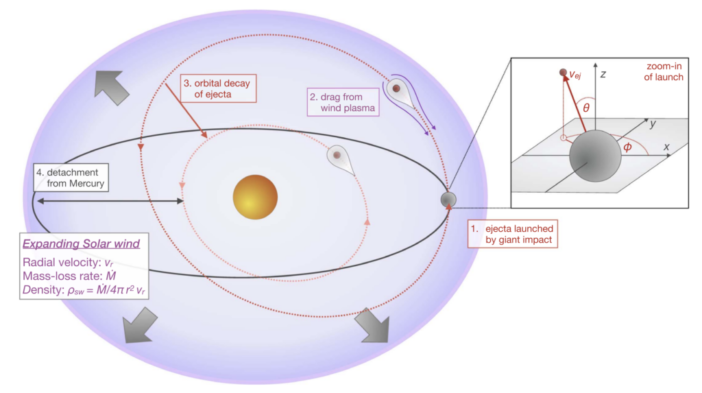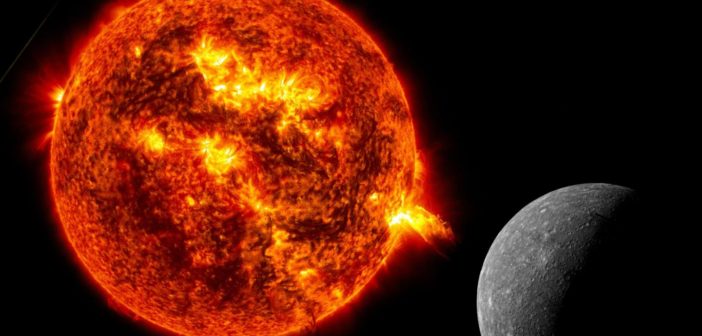Editor’s note: Astrobites is a graduate-student-run organization that digests astrophysical literature for undergraduate students. As part of the partnership between the AAS and astrobites, we occasionally repost astrobites content here at AAS Nova. We hope you enjoy this post from astrobites; the original can be viewed at astrobites.org.
Title: The Solar Wind Prevents Reaccretion of Debris after Mercury’s Giant Impact
Authors: Christopher Spalding and Fred C. Adams
First Author’s Institution: Yale University
Status: Published in PSJ
Mercury is a bit of an oddball compared to the other terrestrial planets. Because of its proximity to the Sun, Mercury doesn’t have an atmosphere, only a “surface-bound exosphere” of gas particles on ballistic trajectories. Under the surface, Mercury has an iron core that extends to more than 80% of its radius, compared with just 50% for Earth.
Many theories have been proposed to explain how Mercury ended up as the planet with the largest core compared to its size. One idea is that Mercury formed with a silicate mantle that was blasted away by asteroid impacts. Another puts forth that as the planets formed from the protoplanetary disk orbiting the Sun, high temperatures sorted out the silicates and iron, so Mercury formed in a region of the disk bereft of silicates to begin with. A third theory states that high temperatures took over after Mercury formed, vaporizing its mantle but not the iron core. The fact that many close-in exoplanets have been found over the last decade with rocky mantles casts considerable doubt on the latter theory.
It is, in fact, a corollary of the first theory that the authors of today’s paper tested. Specifically, they hypothesize that as asteroid impacts knocked pieces of Mercury’s mantle into orbit, the powerful solar wind removed the debris before it could coalesce back onto the surface.
Every Day Is a Windy Day in Space
In 1957, Eugene Parker realized something funny happened when he tried to solve the fluid equations to understand how the Sun’s atmosphere works. At very far distances, he found a discontinuity — the pressure was much lower than realistically possible. His solution was so revolutionary it took three tries to get published: the solar corona is not static but constant expands into space. Parker’s solar wind is composed of supersonic protons traveling at 400 km/s, and it dominates the interplanetary environment as far as the heliopause. Parker’s other major discovery was the spiraling solar magnetic field.
It’s believed that the young Sun had a solar wind about 100 times stronger than today, which is what makes the work in today’s paper possible.
The Giant Impact of Giant Impacts
Mercury’s early history was likely dominated by giant impacts (similar to those that might have formed the Moon), which blasted large amounts of its silicate mantle into space. The pebble-sized debris, left to orbit, would gradually reaccrete onto the surface of Mercury within about ten million years.
But the strong solar wind from the young Sun can push on the debris just enough to modify the particles’ orbits, either accelerating the debris toward the outer solar system or dragging it in toward the Sun. Figure 1 shows a schematic of this system.

Figure 1: Diagram of ejected material orbiting Mercury. The solar wind in this case exerts a drag, reducing the orbital semi-major axis and causing the particle to fall toward the Sun. In other cases, the solar wind can accelerate the particle, causing it to exit toward the outer solar system. [Spalding & Adams 2020]
To test whether the solar wind could be responsible for facilitating the loss of Mercury’s mantle, the authors first looked for an analytical solution by directly solving equations of motion. Despite the simplifications required, they believed the results would be conceptually insightful. They then followed up with a detailed numerical simulation, relying on high-performance computing.

Figure 2: Radial (top) and azimuthal (bottom) velocities of the solar wind as a function of radius for the Sun at ages 3, 10, and 30 million years. Radial velocity increases monotonically but azimuthal velocity reaches a maximum close to the Sun. Super-Keplerian azimuthal winds can accelerate particles outward or inward, depending on orientation. Mercury’s semi-major axis is 0.39 AU. [Spalding & Adams 2020]
Though the azimuthal velocity decreases with distance, at Mercury’s location, it is sufficient to impact orbiting debris with a force, as shown in Figure 2.
The authors added solar wind acceleration to the orbital equations of motion and looked for the decay timescale of the semi-major axis and eccentricity. They varied the age of the Sun, strength of the solar wind, debris launch angle, and starting orbit. In most cases, the solar wind causes debris to decay within about one million years, which is significantly shorter than the ten million years it takes the debris to reaccrete onto the surface, a promising indication for their hypothesis.

Figure 3: Results of numerical simulations with and without solar wind. Of the 110 starting particles, many times more collide back with Mercury in the absence of a solar wind, indicating the wind’s role in stripping collisional debris. [Spalding & Adams 2020]
Figure 3 shows the results, indicating that the presence of even a weak solar wind significantly reduces the number of particles that recoalesce onto the planet’s surface.
Beyond the Solar System
With a combination of analytical and computational methods, the authors conclude that a strong solar wind during the period of heavy impacts on Mercury could have removed ejected material from orbit within less than a million years. Over time, this resulted in Mercury’s silicate mantle being lost into the Sun or toward the outer solar system, leaving behind the iron core.
The authors offer the possibility of utilizing this work in the study of exoplanets. As space physicists learn more and more about the solar wind and heliosphere, attention has turned to astrospheres, heliospheres around stars other than the Sun. Some detections of close-in exoplanets indicate they are iron-enriched like Mercury, leading to the possibility that their composition can be used as an indirect probe of stellar wind characteristics.
Original astrobite edited by Haley Wahl and Wynn Jacobson-Galan.
About the author, Will Saunders:
I am a third year Ph.D. student at Boston University, where I study planetary atmospheres. I work with Prof. Paul Withers at BU and Dr. Mike Person at MIT using stellar occultations to measure waves in the atmospheres of Mars and Uranus. I received my Bachelors in Physics from the University of Pennsylvania. I am so excited about founding and co-hosting the podcast astro[sound]bites. Check us out on astrosoundbites.com, Apple Podcasts, Google Play, SoundCloud, and Spotify. In my free (pandemic) time, I enjoy biking, outdoor dining, and walking around Boston.

